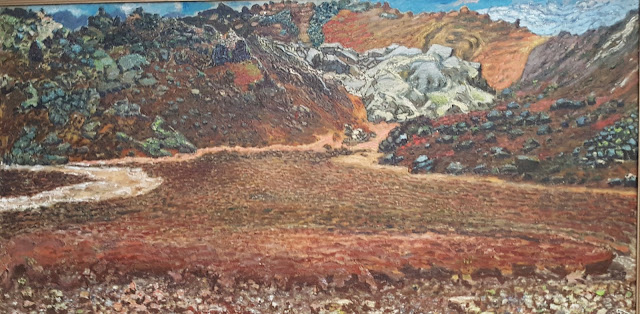Two small museums offered a glimpse at two of the most famous artists. Named after painter Johannes S. Karval (1885-1972), the Kjarvalsstadir Museum had only two exhibit spaces: one with Karval's paintings and another for contemporary exhibits. In this post, I will share what I saw at this one museum.
 |
| Mouth of a Fjord, 1947 |
Karval's work was often based on Icelandic myths like this painting of a ship being blown by a god-like figure.
This painting depicts very human-looking elves around their rock dwelling place.
In Iceland the traditional belief is that supernatural creatures inhabit wild places especially around the abundant boulders scattered everywhere. These creatures can be a nuisance to humans if they are disturbed. These elves appear rather ominous and aloof - I would not mess with them.
 |
| Elves' Rocks, 1935 |
This painting depicts very human-looking elves around their rock dwelling place.
In Iceland the traditional belief is that supernatural creatures inhabit wild places especially around the abundant boulders scattered everywhere. These creatures can be a nuisance to humans if they are disturbed. These elves appear rather ominous and aloof - I would not mess with them.
 |
| Shield Maiden, 1961 |
 |
| Fantasy, 1947 |
 |
| Spring Thaw at Mt. Esja, 1956-7 |
Landscapes depicted the spectacular natural areas in Iceland. This snow covered mountain looks like the scenes we saw in late February and early March.
This painting shows a bit of the Unesco World Heritage site Pingvellir, an area of deep chasms and a vast plain still actively being formed by the movement of the earth's tectonic plates. Here is where the early government of Iceland was formed, outside against the amphitheater-like cliff walls.
Here I am with a lovely painting of rocks and lichen, so you can see, the landscapes are often quite large. If you look closely, can you see elves? There must be some magical creatures hidden in this richly textured canvas.
I love the glimpse of a white glacier beyond the far mountains.
Karval is a beloved painter of Iceland who in return loved his country. He was the artist who awoke and educated the average, reserved and stoic Icelander to the mysteries of art with paintings of subjects they could relate to. Finding the words to explain art was not easy for him, he said - he probably had the same struggle with shyness that is a cultural trait for many Icelander - but he succeeded. Now Iceland is a country where art is widely seen in galleries, museums and even tourist shops .
Next post: the Asmundarsafn Museum.







No comments:
Post a Comment
please leave feedback. thanks!